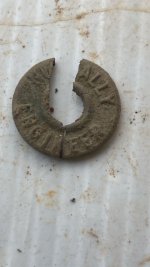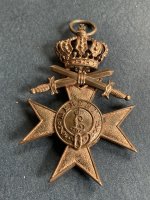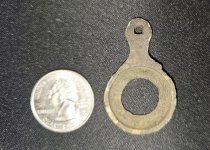Gypsy Heart
Gold Member
Willow Creek Depot, the old British army and naval outpost at the edge of Minesing Swamp, was the twin of Barrie when both communities were born at either end of the Nine Mile Portage. The depot, for all intents and purposes, died in the early 1800s, after a few decades. It still lives on as an interpretive centre today.
And in the memories and imagination of many early Vespra families (now part of Springwater Township), Willow Creek Depot was more than an odd clearing in the bush. It was a place of treasure. And we ain’t talking old square nails, broken bits of red clay brick or the odd Broad Arrowhead emblazoned piece of British military kit. We’re talking gold.
The Barrie Examiner first started reporting on the buried gold in the 1930s. “Families in the Minesing and Mac area are talking about the strangers who came and camped out at the old Fort (sic) for a few days before disappearing, leaving only a series of holes in the Fort area,” says a piece in the old gossip section of The Examiner in the spring of 1932. The story was that the British decommissioned the depot in the early 1830s and the corporal, the lone soldier at the depot, couldn’t carry the gold for the Penetanguishene payroll on his own, so he buried it. He left written directions that were indecipherable or got lost and he was transferred to India or some other remote location and the gold was never picked up. A true story about a corporal who went missing while stationed at the fort added to the intrigue. The most famous version of the story names a Corporal Cannon – although there is no Cannon on the rolls of the depot, there is a Kiernan. And while a Cannon is lost in the swamp – it fell off the corduroy road as it was hauled along the portage to be transported to Penetanguishene - that was a gun not a corporal. The missing corporal went hunting one fall day when his wife was in Penetanguishene about to give birth to the couple's third child. The other two children were staying at the depot in the family residence. A man named Lawrence paid a visit to the residence and learned the corporal was out and said he would see if he could find him. There was a gunshot a while later and the corporal was never seen again. Lawerence said he never found the corporal. So one version of the story goes that the corporal's death left the payroll hopelessly buried somewhere in the vicinity of the depot.
And so it sat, for decades, in the sandy soil atop the ridge overlooking the swamp. The railway went through between the depot and the swamp digging up a grave site of nine bodies, adding to the mystery. The Examiner also reported in the fall of 1957, in a piece by W.A. Bell, that people arrived at the depot with “powerful magnets” to look for the cannon that had fallen off the trail into the swamp during the War of 1812 and was left to sink in the muck. Bell, in the same piece, recounted how Mr. Pringle (George Pringle of Concession 10, Vespra) thought a family by the name of McBride used to probe for the treasure and then one day, built a new house.
Bob Campbell, who grew up on the Nottawasaga River at Edenvale, moved to British Columbia after living at Glengarry Landing from 1872 to 1893. He wrote in The Examiner in 1951, from northern British Columbia, to tell of the treasure he found from the War of 1812.
“I still pack around some of the mementos of the old place – a perfect stone-fleshing knife and a chain that the curator of the Provincial Historical Museum in 1906 believed came from the old Nancy (boat).”
Campbell also had possibly the earliest brush with the treasure seekers. They arrived at his family’s Glengarry Landing farm to seek a “keg of gold”. No mention of leprechauns, but they did have “a contrivance that gold would attract. It was a silvery-looking cylinder about six inches long and one and a half inches in diameter. On either side was a small spout, into which he inserted pieces of cane.” According to Campbell, the searchers spent a couple of days searching with no luck.
By Tom Villemaire
And in the memories and imagination of many early Vespra families (now part of Springwater Township), Willow Creek Depot was more than an odd clearing in the bush. It was a place of treasure. And we ain’t talking old square nails, broken bits of red clay brick or the odd Broad Arrowhead emblazoned piece of British military kit. We’re talking gold.
The Barrie Examiner first started reporting on the buried gold in the 1930s. “Families in the Minesing and Mac area are talking about the strangers who came and camped out at the old Fort (sic) for a few days before disappearing, leaving only a series of holes in the Fort area,” says a piece in the old gossip section of The Examiner in the spring of 1932. The story was that the British decommissioned the depot in the early 1830s and the corporal, the lone soldier at the depot, couldn’t carry the gold for the Penetanguishene payroll on his own, so he buried it. He left written directions that were indecipherable or got lost and he was transferred to India or some other remote location and the gold was never picked up. A true story about a corporal who went missing while stationed at the fort added to the intrigue. The most famous version of the story names a Corporal Cannon – although there is no Cannon on the rolls of the depot, there is a Kiernan. And while a Cannon is lost in the swamp – it fell off the corduroy road as it was hauled along the portage to be transported to Penetanguishene - that was a gun not a corporal. The missing corporal went hunting one fall day when his wife was in Penetanguishene about to give birth to the couple's third child. The other two children were staying at the depot in the family residence. A man named Lawrence paid a visit to the residence and learned the corporal was out and said he would see if he could find him. There was a gunshot a while later and the corporal was never seen again. Lawerence said he never found the corporal. So one version of the story goes that the corporal's death left the payroll hopelessly buried somewhere in the vicinity of the depot.
And so it sat, for decades, in the sandy soil atop the ridge overlooking the swamp. The railway went through between the depot and the swamp digging up a grave site of nine bodies, adding to the mystery. The Examiner also reported in the fall of 1957, in a piece by W.A. Bell, that people arrived at the depot with “powerful magnets” to look for the cannon that had fallen off the trail into the swamp during the War of 1812 and was left to sink in the muck. Bell, in the same piece, recounted how Mr. Pringle (George Pringle of Concession 10, Vespra) thought a family by the name of McBride used to probe for the treasure and then one day, built a new house.
Bob Campbell, who grew up on the Nottawasaga River at Edenvale, moved to British Columbia after living at Glengarry Landing from 1872 to 1893. He wrote in The Examiner in 1951, from northern British Columbia, to tell of the treasure he found from the War of 1812.
“I still pack around some of the mementos of the old place – a perfect stone-fleshing knife and a chain that the curator of the Provincial Historical Museum in 1906 believed came from the old Nancy (boat).”
Campbell also had possibly the earliest brush with the treasure seekers. They arrived at his family’s Glengarry Landing farm to seek a “keg of gold”. No mention of leprechauns, but they did have “a contrivance that gold would attract. It was a silvery-looking cylinder about six inches long and one and a half inches in diameter. On either side was a small spout, into which he inserted pieces of cane.” According to Campbell, the searchers spent a couple of days searching with no luck.
By Tom Villemaire





